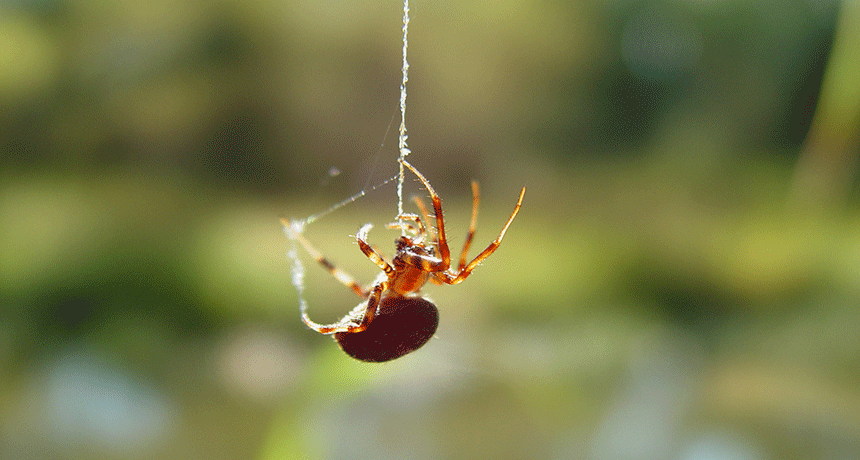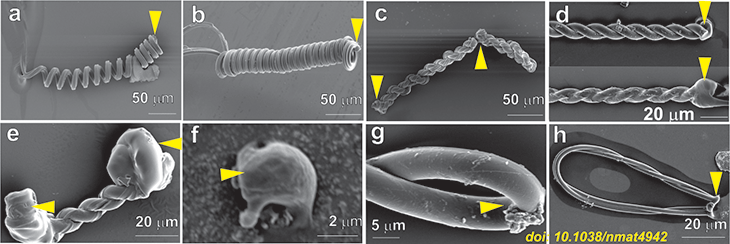Lasers can turn a spider’s silk into sculptures
Scientists create surprising shapes and weld silk to other materials

Using lasers, scientists in India have been able to sculpt a spider’s silk, like the type shown here, into a variety of shapes.
mpiokpee/istockphoto
If physicist Kamal Singh needs material for his experiments, he heads to his garden. After all, that’s where the spiders live. He and his colleagues have found a way to sculpt spider silk into a dazzling variety of shapes.
They’ve created silk loops, twisted chains and coiled springs unlike anything a spider ever produced. They even built a Möbius strip, a twisted cylinder with only one side. Those researchers showed how to attach silk to other materials, including metal and glass. Singh hopes his team’s technique could have medical uses, like creating new bandages for wounds or burns.
Singh lives in Mohali, India. There, he works at the Indian Institute of Science Education and Research. His garden is home to thousands of spiders. To gather the silk he works with, he coaxes a spider onto a stick. Then he gives that stick a quick jerk. The spider leaps away, trailing behind it a pristine line of silk. And now Singh has what he needs.
To build things out of the silk, Singh’s group uses a femtosecond laser. This is a tool that sends out powerful pulses of light that are very short. How short? Each pulse lasts only a few femtoseconds. (A femtosecond is 0.000000000000001 second. That means there are a thousand trillion of them in one second.) Spider silk can start out about 1/20th the width of the average human hair. The researchers use their laser to then tailor that silk into new shapes. That laser can make very precise cuts, remove sections of silk or attach the silk to other materials.
Story continues below image

The researchers described their technique in the September Nature Materials.
Sculpting silk with lasers shows “you can use light to do really amazing things with protein-based materials,” says David Kaplan. He works at Tufts University in Medford, Mass. Although he did not take part in the new work, this biomedical engineer has studied spider silks and similar materials. He focuses on the proteins that give those silks their strength and stickiness.
Beyond webs
Spider silk has long fascinated Singh. When he arrived in Mohali eight years ago, he initially focused on silk’s strength. “If you take silk and twist it, it can absorb a great amount of strain before it fails,” he notes. So he and his graduate students twisted. And twisted. And twisted. Then twisted some more.
“We did it for a couple hours. Then we did it for five hours, six, then 10 hours,” he says. In the end, they kept at it for 10 days! “We were taking turns. Everyone was exhausted.” His graduate students even slept near the experiment. Still, the silk never failed.
Spider silk is stretchy, strong and super-sticky. (That’s why Spider-Man uses it to stop runaway trains and rescue people from bad guys.) Singh wanted to cut and sculpt the material. He knew he couldn’t use a scissors and glue. “To cut silk with high precision, we can’t use conventional tools,” he realized.
And that, he notes, is where his team had to get innovative.
A few years after those first twisty experiments, their lab got a femtosecond laser. It was for tests of photons (particles of light). And almost at once, Singh says, “The idea clicked.” This laser also would be perfect for sculpting silk. It could carefully deliver a big burst of energy into a really tiny area. And its short pulses would keep that energy from destroying the silk.
First, the team first had to figure out which type of light would work best. Silk is transparent to visible light. Light passes right through. (It’s why you might not notice a web until you walk through it.) In contrast, spider silk absorbs ultraviolet (UV) light, which has shorter wavelengths than visible light.
And strong UV pulses, the researchers showed, cut the silk. With weaker pulses, they could add just enough energy to change the silk’s structure. After a pulse, Singh says, “We believe [the silk] becomes a liquid state for a very small amount of time.” That makes the material bulge, or seem to swell.
By bulging and cutting the silk, the researchers could sculpt it into different shapes. When they put the silk onto something like glass or metal and fired a pulse, this welded the silk to the material. They even stuck spider silk onto ordinary contact lenses.
Kaplan says the new experiments show the versatility of spider silk. Scientists might be able to combine silk with other materials to make new kinds of useful products. “The material in and of itself is great,” he says, “but it still has to interface with the world around it to make an impact.”
Kamal says he’s now looking into a range of possible uses for his technique. Those include shaping silk into strong bandages that don’t weaken in wet places. Such bandages could help fix bone fractures or repair skin or other tissues.
But to keep experimenting, he’ll need more silk. And that means it’s time to go back to the garden.







